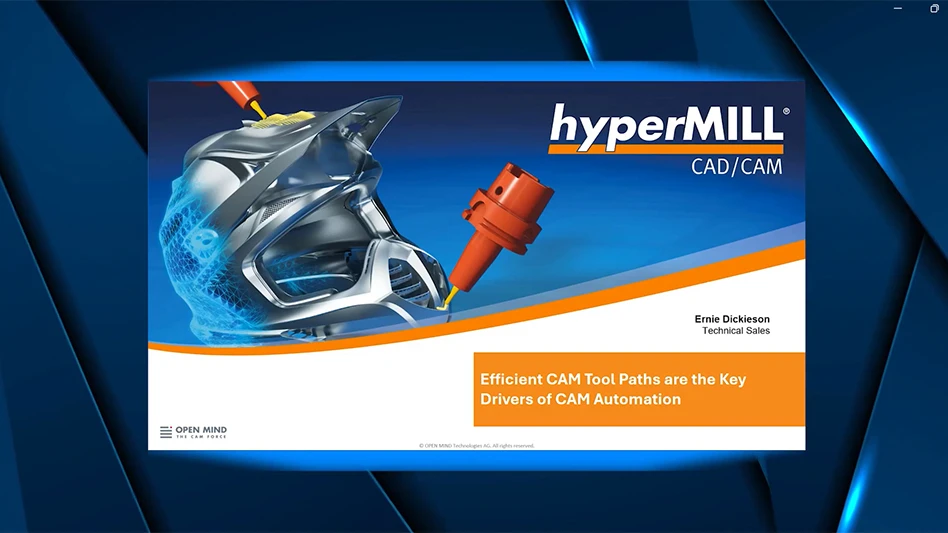
Necessity is often the mother of invention as aerospace supplier V&M Precision Machining & Grinding found when it recently faced a last-minute material substitution. The 155 circular stainless steel used to machine a landing gear component became unavailable, and V&M had to machine rectangular 300M stainless – 7.5" square block with a 65" length.
The component was an orifice tube. A cylinder with slots in strategic locations, it is controlled with an air cylinder via a metering pin, which acts as an air shock absorber to take the first impact upon landing. After that, the hydraulic system takes over.
There is Always More to Learn
V&M is no stranger to the demands of the precision aerospace industry. Established in 1963, it serves OEMs and Tier suppliers including Boeing, Northrop Grumman, and Goodrich Aerostructures, as well as Fuji Heavy Industries and Kawasaki Aerospace division in Japan.
Prior to purchasing V&M with brother Tom early in 2005, Dal Rogers owned two other machining companies. However, they specialized in airframe components, not landing gear parts.
"I had been machining a lot of aluminum and titanium, but landing gear relies more on hard metals," says Rogers. "This is where Seco really helped me out. Application Specialist Bob Hoggatt suggested new shopfloor applications that I had only read about previously."
One was plunge milling to make a square into a round – a perfect solution for the orifice tube. Plunge milling is a highly productive, axialmachining operation for metal removal, performed in a single tool sequence. The tool makes a series of overlapping plunges to remove part of a cylindrical plug of material. Due to the increased rigidity of a Z-axis move, the tool covers a larger cross-section of material, resulting in shortened production cycles and increased efficiencies.
While several standard Seco milling cutters can be used for plunge milling, Hoggatt recommended the Seco R220.79-03.00-12 plunge mill cutter. V&M ran the 300M forged bar on its Mori Seiki 3-axis mill with a 25hp spindle at 525rpm, 20ipm, and 0.004" stepover. Rogers comments, "It's an older machine, but reliable, and we saved at least 50% machining time over a typical endmill or facemill method." V&M was able to rough machine the 8" rectangle to a 4" cylinder in only two hours.
Enter Grade TP2500
After machining the rectangle into a round, V&M had to perform finishing operations. Hoggatt suggested Seco's Duratomic generalpurpose, turning-grade TP2500, with coating manipulated at the atomic level. Field tests showed tool wear increases up to 400% in conjunction with 100% productivity gain.
As a new application, no baseline had been established. The component was run on V&M's Mitee VT40A Viper Lathe with the TP2500 CNMG 643W-MR7 chipbreaker insert. Says Rogers, "It took a while to get the optimum feeds and speeds, but with Hoggatt's guidance, we got it right."
V&M was getting two passes per edge, even with the interrupted cuts. "We were taking a 0.200" depth of cut and 2.9ipm on the first pass to achieve 14.4 in3 of material removal per minute; then a 0.310" depth and 4.1ipm on the second for an amazing 31.2 in3 of material removal," Rogers says. "The cutting length on both passes was 36.5"."

Finishing operations on the orifice tube are performed on V&M's Mitee VT40A Viper Lathe with the Seco TP2500 CNMG 643W-MR7 chipbreaker insert.
Hoggatt notes, "Our chip form was perfect and cutting speed was consistent at 196rpm and 400sfm on both passes. We increased horsepower from 17.1rpm on the first pass to 37.1rpm on the second."
Ironically, Hoggatt brought only four samples of TP2500 to run the nine orifice tube components, but they performed so well V&M didn't have to make any purchases to run this job. Hoggatt gained efficiency by using the 100° side of the corner of the CNMG insert. "It's a stronger corner to use as a lead angle, so it thinned the chip better and allowed us to go faster," explains Rogers. "Although the TP2500 was an ‘unknown' to us, it's an excellent choice for many applications in our shop. We're now trying it on smaller machines and it's reducing processing on many jobs by 50% to 60%."
Although V&M's distributor represents many cutting tool suppliers, Rogers admits they turn to Seco when they have the time and production capacity to analyze the best options.
"Tool companies give you all the data you need when you buy the tool. However, workers are not getting the shopfloor education to optimize the cutting tool operations. Partners like Seco help us train our staff and achieve optimum efficiency."

Explore the March April 2008 Issue
Check out more from this issue and find your next story to read.
Latest from Aerospace Manufacturing and Design
- Piper Aircraft receives its largest ever domestic trainer order
- Miniature, high force-to-size linear voice coil servo motor
- MagniX, Robinson to develop battery electric R66 helicopter
- Zero-point clamping modules
- Hartzell electric engine propeller earns FAA approval for AAM
- Thin profile flame and thermal barrier
- Guill Labs offer materials and extrusion testing
- High production vertical honing systems





